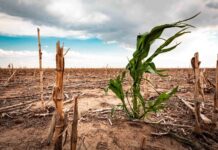African countries face great challenges in adapting to climate change to meet growing demand for food with the current drought in East Africa being the latest manifestation of changing weather patterns.
But, according to experts, countries such as Zambia, where there is good land and water, have major opportunities to meet food demand by growing agriculture exports and processing their produce.
Zambian farmers can earn substantial returns from increased production. Their production can also alleviate the pressures in countries such as Kenya.
This is a recent analysis made by Antony Chapoto, the research director at the Indaba Agricultural Policy Research Institute (IAPRI), Ntombifuthi Tshabalala, an economist at Centre for Competition, Regulation and Economic Development, University of Johannesburg, and Simon Roberts, a Professor of Economics and Lead Researcher, Centre for Competition, Regulation and Economic Development at the same university.
“To realise these opportunities, Zambian products have to reach export markets at good prices. For this, Zambia needs competitive cross-border markets and efficient transport and logistics services,” they noted.
“However, regional grain and oilseeds trade is not working for producers in Zambia or for buyers in East Africa, with huge variances in agricultural commodity prices in Kenya and in Zambia.”
They said there “reality check” on the workings of cross-border markets points to regional integration being the key to unlocking massive potential for Zambia to anchor sustainable agricultural growth in Africa. But effective regional integration remains a dream, undermining Zambia’s potential.
“Zambian agriculture has been a growth story with expanding net exports in important products such as soybeans. However, this performance is very short of where it should be. Zambia should be the grain basket for the whole region. Malawi has shown what is possible in soybeans. It almost doubled production in 2019/2020, to 421 000, more than Zambia in that year.”
The experts said the major issue was how cross-border markets were working, or not working and Zambian suppliers report having substantial volumes of soybeans which can meet the huge regional demand.
“Though lower than Kenya’s, Zambian maize prices are still substantially higher than last year’s. This is in line with global trends. With higher input costs, farmers need higher output prices to incentivise production.
“The gap between prices in Zambia and those in Nairobi and Kampala is close to US$300/Mt. This is double what would be explained by the efficient cost of transporting maize from Zambia to these countries. Efficient transport costs take account of reasonable trucking, logistics and border costs.”
They argued that producers in Zambia should be getting more for their crops and buyers in East Africa should be paying less, alleviating the food price spikes there.
However, a combination of factors were undermining the growth of Zambia.
“First, reliable market information is required to link buyers and suppliers, and to enable markets to work. In the absence of information, it’s risky to export.
“This lack of information affects small and medium sized farmers and businesses. Large-scale traders who have operations across the region have an advantage over smaller businesses and farmers because they have private information.”
They added: “Second, the market players require clear trade policy signals to take advantage of export opportunities. Any hesitation or mixed signals tend to undermine the ability to make deals with confidence.
“It is therefore important for Zambia’s new government not to impose ad hoc trade restrictions, for example, as the previous government did in August 2021 to restrict maize exports. Such restrictions, imposed and lifted from month to month, mean deals cannot be made with the confidence that they can be fulfilled.
“Third, the market opportunities in East Africa require urgent regional co-operation to improve transport corridors on the ground rather than in rhetoric.”









